The Lowdown
Lies of P has amazingly fluid gameplay once you get used to it, a beautiful atmosphere, a multitude of ways to overcome obstacles, and a pretty interesting story to boot. That makes this one of my favorite games in this genre, and while I will probably be taking a break to play some other titles, I will be 100 %-ing this, too.
Overall
Pros
- Combat system that encourages experimentation
- Creepy but beautifully designed world
- Fluid gameplay
- Interesting story
- My “Game of the Year” from 2023
Cons
- Some not entirely useless but underdeveloped mechanics
- A ho-hum endgame to cap off your journey
Dear Readers, we may have found the 2023 Game of the Year in Lies of P. I’ll admit, when I first saw the game pop up on Steam, my first reaction was, “What a fricking stupid name.” Once I got over my initial revulsion (and admittedly waited for it to go on a small sale), I dove into the discourse surrounding this game to see if it was something truly worth playing. As far as I knew, it had a gameplay loop reminiscent of the much-accredited Dark Souls franchise, where punishment is your only friend as its core alluring trait.
I’m a Dark Souls veteran and have played a few of their games very thoroughly, so this seemed to be something I’d be interested in. There’s been a lot of hoopla this year about other titles, but I am coming right out and saying that Lies of P deserves a crap load of applause for the effort put into it.
I’m currently in my second Lies of P playthrough, and I’ve played for about 30 hours at the time of writing this; here are my thoughts.
Now that we’re out of the intro and I can cut loose a little, let’s talk about me. I’m a simple man, and few things in this world motivate me more than any other: 1) the promise of a good night out with various substances that may or may not be legal. 2) the smell of a good dinner after a hard day’s work. 3) spite; sheer unfiltered spite.
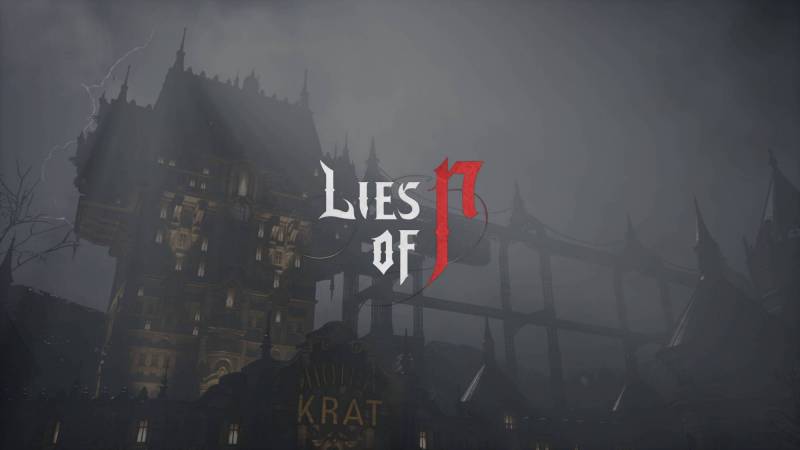
The Dark Souls franchise has a huge fanbase, and rightfully so. It’s a tough series of games made by a celebrated studio that pits a single character against colossal odds and monsters.
Is it perfect? No. There are many annoyances that seem to be slapped in there simply to make the games harder, but it still was — and is — an absolutely revolutionary concept that deserves its success.
…..but people, some of y’all take it way too far.
I’ve come across many a discourse where the community has a tendency to applaud the most annoying aspects as integral to the experience and, via online messaging, verbally accost (because you know these basement-dwellers don’t do shit in real life) anyone who has the cajones to criticize what is in their mind “God’s gift to gamers.”
You hate the fact that the story of a Dark Souls game is convoluted and, at times, nonsensical? Too bad, they’ll call you a troglodyte with minimal attention span.
You hate the fact that enemies are placed in annoying locations to hit you from your blind spot? Too bad; you suck at this game, and therefore your opinion is invalid.
You hate the fact that respawn points are incredibly far away from bosses, so you have to navigate rock-throwing giants, a poison swamp, AND a multitude of other enemies just for the opportunity to get slapped around like a misbehaving kid? Too bad. Go play Stardew Valley because you’re a casual.
So on and so forth, there is always an excuse in the chamber for why criticism of the Dark Souls franchise and their developer FromSoftware is, in fact, a fundamental misunderstanding of what the developers intended.

If you are one of those people who believe or has said any of the things I typed above and, on top of this, are trying to gatekeep new players from sharing their experiences and opinions, first of all, f*ck you, and second of all, don’t come at me because I actually know what I’m talking about.
To list my credentials:
I beat Dark Souls 1 twice with no summons, took down Gwyn Lord of Cinder without taking a hit, and beat Chaos Witch Queelag while on a flight to Europe with my mouse wedged under my ass because airplane seats are minuscule.
I beat Sekiro so many times I’ve 100% the game AND did an item/enemy randomizer just for fun.
I beat Elden Ring with no summons and without using a broken-ass build (looking at you magic beam users). By the way, this includes taking down Malenia (arguably the most difficult boss in any FromSoftware game) with nothing more than a shield, a sword, and a dream.
Begone, peasant, your mom has made you hot pockets; go scarf it down and sit in the corner like a good boy.
ANYWAY, what’s the point of this rant?
Well, you can imagine my glee when I saw that at launch, Lies of P was flooded by comments from supposed Dark Souls veterans expressing their absolute displeasure at the gameplay and experience. Comments were all over the map in their criticisms.
Some didn’t like the fact that your character couldn’t use a weapon with two hands. Some said it was stupid your character didn’t have hyper armor (basically, when you swing, you are allowed to complete the swing instead of getting interrupted by an enemy attack), so they can just take hits to the face without interruption while swinging a slower weapon (because that’s skill apparently).
Some even said it was IMPOSSIBLE to beat this game using a strength-based build as those typically have lower swinging speeds, and therefore, timing windows made it unviable.
So naturally, I beat the game using a strength build, just to be petty.
None of these criticisms held any weight with me, and if these gameplay aspects made Lies of P so unviable to play a certain way, how could I do it while elbows deep in alcohol half the time? Exactly.
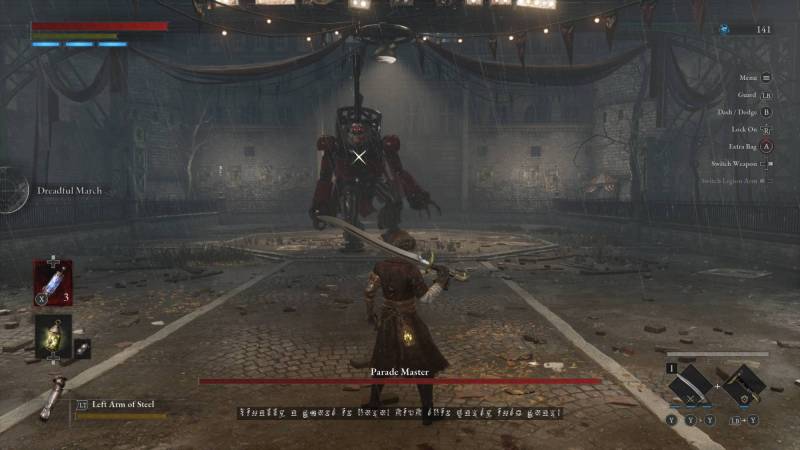
Obviously, everyone is entitled to their opinion, but I can’t help but detect a level of intellectual dishonesty. I believe that if FromSoftware had made this game, these twats wouldn’t be able to stop sucking it off.
It is apparently very easy to discredit this as a “Dark Souls clone that doesn’t have the magic of the original,” but it really is so much more.
I’m not saying there aren’t similarities, as Lies of P takes a lot of inspiration from the Dark Souls series, but the knuckle draggers who seek to put down a very solid experience because Miyakazi (the Dark Souls developer) didn’t drape his nutsack over it should be ashamed of themselves.
Finally, the Lies of P Story
Now that that’s out of the way, In Lies of P, you play as Pinocchio. Yes, that Pinocchio, the boy who lied so much his nose defied reality.
You’re based in the City of Krat, where technological advances spurred by your father, Geppetto, have led to the creation of mechanical automatons called Puppets that have taken over most of the menial tasks/jobs.
This is all possible due to the discovery of a power source called Ergo. Ergo is an extremely efficient power source that has woven itself into the very fabric of society.
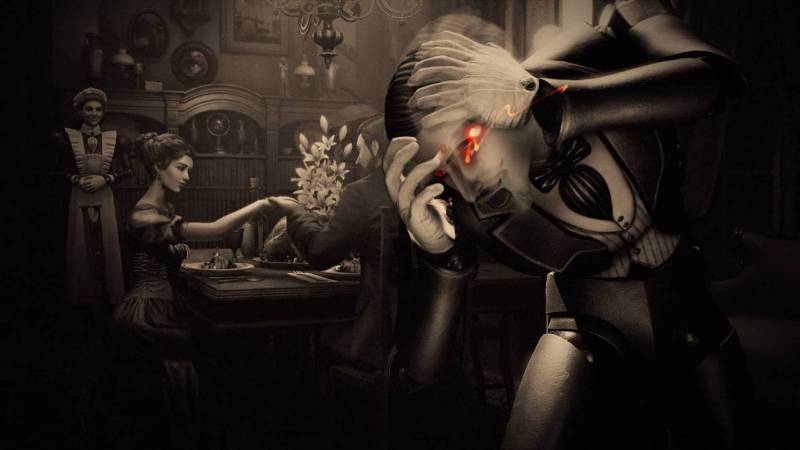
Pictured: Me hearing about crypto for the nth time
These puppets are bound by a set of rules akin to “I, Robot,” so they can never harm a human, but things do not go as planned. One fateful day, puppets all over Krat rose up and started killing humans left, right, and center.
Society has collapsed, and it is your job as the protagonist to identify what caused this.
Based on a fairy tale, you meet humanized characters like the Fox and the Cat from the original story, and the beloved Jimminy Cricket is now a lantern attached to your hip called Gemini that provides information on the area as you need it.
He’s much more annoying this time around, but it’s still fun and whimsical that they took the time to incorporate this.
I felt this game wove pretty interesting concepts into the narrative. While communicating with various quest givers and key characters in your home base of Hotel Krat, you are sometimes given the option of telling the truth or lying to them.
Puppets in Lies of P are encoded to only be able to tell the truth, but Pinocchio seems to be the sole exemption to this.
Choosing whether to be truthful or not directly impacts the subsequent ending you will unlock in Lies of P, but also our protagonist’s growth as a character.
As you exert more free will, your character model actually changes to a more fleshy tone as opposed to what I can only assume is ivory or porcelain. This is a sign of your humanity increasing through your actions.
What’s more, helping people out with their requests and listening to vinyl records will also increase your humanity. I liked this, too, as a reminder that to be human is to live for others and to enjoy art. Gotta keep that in mind sometimes.
As you progress and without spoiling too much, later in the game, you find more evidence that puppets simply aren’t mindless and are more akin to enslaved people bound by the covenant of rules Geppetto has placed on them.
This has really morbid implications and blurs the line as to what makes a machine and what makes a man.
I LOVE dichotomies like this, so I got a real kick out of uncovering the story and making these decisions.
The setting is also very beautifully done and perfectly encapsulates the decline of some industrial-era European cities. As most of your enemies are puppets or similar mindless drones, you’ll never really know where they may be hiding, leading to some creepy surprises here and there as they pop out of the environment.

It’s not all Gothic architecture.
Often, I found myself taking a moment to stand at a vantage point, not only to plot out my route but also to admire the environment.
I remember exploring an opera house, and the sheer creepiness made the hairs on my neck stand up, as the sound design married the visual assets quite superbly. The echoing hollowness and the seeming emptiness somehow juxtaposed with the gentle click-clack of something metallic with many legs walking around the upstairs veranda just out of sight. Chilling.
While the Lies of P maps aren’t overly complicated to navigate, they are dense, and an easy stretch of road may actually be covered in traps and enemies that have yet to reveal themselves. It’s really well done from an A/V standpoint and well done on the designer’s behalf.
So now, onto the gameplay.
Basic Lies of P Gameplay Loop
As mentioned, Lies of P is inspired by the Dark Souls series for its gameplay loop. You will be tasked with beating the tar out of anyone that comes in your way and through the Ergo (souls) that they drop, leveling up your character to put out more damage, have more health, be able to carry more equipment, etc.
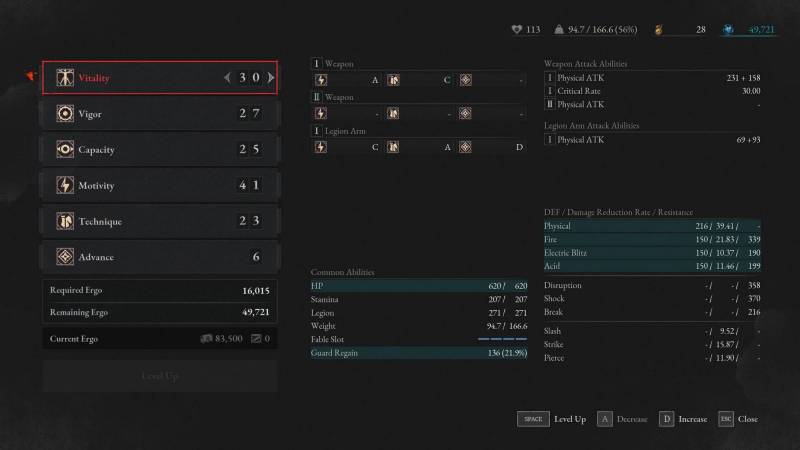
Besides the brutality, one of the main reasons I found Lies of P so likable was the developer’s seeming interest in allowing their players to experiment with different playstyles to find the one that best suits them and gets really good with them.
I’ll walk you through a few key components of the architecture, and you’ll see what I mean.
Firstly, progress is denoted not only by the bosses you overcome but by the points of safety and recuperation scattered across the various maps. What you may know as bonfires in this world are called Stargazers. Despite looking like an upside-down umbrella, you’ll quickly come to feel a rush of relief when you see one spinning stupidly in the distance.
Right off the bat, you can teleport between these safety points, which cuts down on a lot of the needless and asinine wandering that you may come to expect from Souls-like games.
While some may moan that this diminishes the difficulty, I, in fact, think that providing this ability from the get-go allows players to go back to areas previously explored and not only practice their combat against enemies that they’re having trouble with but also to see if a new skill/weapon combination is viable for their playstyle.
For example, let’s say you’re having trouble fighting enemies in a mid-late game area called the Lorenzini Arcade because you haven’t quite mastered their moves and can’t predict their actions.
As it is a later-game area, these foes will hit very hard by default and crush those who aren’t ready. If you want to get some practice, instead of backtracking for 15-20 minutes to where you need to go, you can head to a prior map with similar enemies via teleportation through a stargazer and practice against them.
They may still be difficult, but they will not hit nearly as hard, and you will get more valuable experience within 5 minutes of deciding to do so.
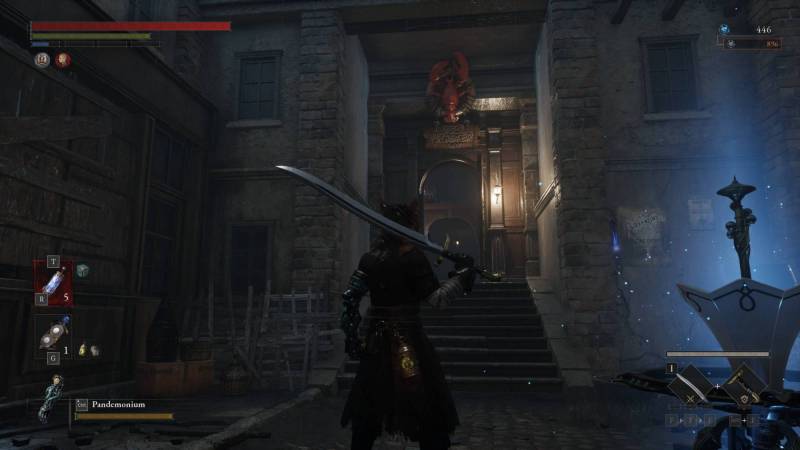
No wonder this place sucks, it’s Boston.
Enemies, in general, range from regular drones to elite enemies to full-on bosses that have their own individual health bars and combat styles. As you may have guessed, learning the patterns of their attack and your own defense maneuvers is essential for success.
None of the bosses are alike, which was quite enjoyable because every new fight with one of these gigantic people was like unwrapping a new puzzle. I don’t want to spoil it because one of the most amazing aspects of these games is entering a room and having a behemoth drop-down to impede your progress.
The only thing that you should be aware of is that a lot of bosses have multiple phases, so don’t let them catch you off guard just because they fall down.
Despite the varied and diverse catalog of foes stomping on your face, your primary defense and offense tools are separated into four categories: weaponry, your cyborg right arm, a dodge move, and the ability to block/parry attacks.
These components blend into each other pretty intuitively, and some combinations will work better with others based on you, the player.
In terms of weaponry, this is another layer that seems to follow the ethos of “try it! See what happens!”
Each weapon you collect (with the exception of unique weapons you get from bosses) can be separated into a hilt that you hold and an “end” that you smack with. These can be mixed and matched with each other to find the combo that best suits your playstyle.
No hilt has the same swinging pattern, speed, or reach, and no “end” has the same damage output or reach. Moreover, each component comes with a special ability, to boot!
The point is, there are 100s of combo options to choose from, and seeing as there is no in-game cost to swap these bits around, this is another instance of the game rewarding player agency and creativity.
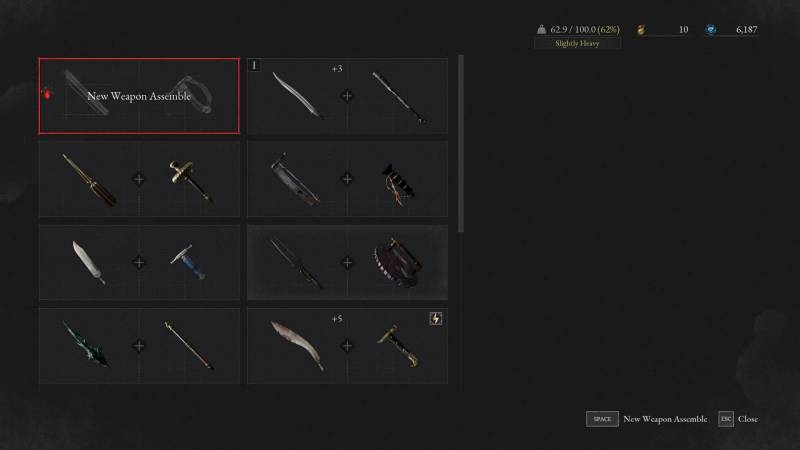
Then you have your left “Legion Arm” that can be equipped with a separate gadget to add some additional chaos to the playing field.
There’s a flamethrower, a shield, and a rocket launcher, amongst others, but the one I stuck with the most was a zipline harpoon that either pulled me towards my hapless victim or pulled them within range of my slapping stick. As mentioned 1500 words ago, I am a simple man, and it suited my personal playstyle the best.
Dodging and blocking are relatively straightforward to understand, but each comes with its caveats.
First of all, at the beginning of the game, dodging is not as effective as a Dark Souls veteran may expect. The “invulnerability” frames (i-frames) that you get as a baseline are simply not sufficient for dodging yourself away from some truly massive hitboxes or long, drawn-out attacks.
You can upgrade this pretty early on to grant you more i-frames, and I would say this is probably the one thing that should be consistent across every player’s combat repertoire.
You need an effective dodge as a last resort, so suck it up and upgrade it.
Blocking has varying mileage for players based on their skill level, comfort with the timing, and their weapon size. This all matters because when you block right at the moment an enemy’s attack hits you, you perfectly parry the attack and take no damage.
If you miss this window, you take “chip damage,” which is not the full brunt of the attack but a percentage of it.
The girthier your weapon is, the less chip damage you get. It makes sense that absolute hogs of weapons are better at protecting you, but to put it simply, heavier weapons are better at blocking and doing more damage but swing MUCH slower. In contrast, something lighter will have the opposite effect.
The final thing you have to understand at a glance is called stagger; it can be considered how much force you directly apply to an enemy that doesn’t take away from their health. You connect with an attack and damage them, and stagger is generated.
You shoot them with an explosive, and stagger is generated. You perfectly block an attack, and stagger is generated.

Behold, get bonked!
This is an invisible meter that you can’t really see how much has been built up on an enemy, BUT doing so can be incredibly beneficial.
When stagger is built up to a sufficient level, you will not only possibly snap an enemy’s weapon if they are using one (neutering their damage output), but you will also put the enemy in a temporarily defenseless state. This allows you to supercharge a critical hit straight into their stomach.
The timing of this state is very short, so take advantage while you can.
So, to sum up, the combat style that I settled on after a lot of experimentation, my guy was a big, bony boy who blocked foes’ pathetic hopes and dreams with my parrying. When they inevitably tried to escape my cruel machinations, a harpoon to their face brought them back within arm’s reach.
I am inevitable, and the game’s systems allowed me to discover which stuff I liked best.
Now, in addition to being able to travel anywhere, you’ve been pretty easily and tinker around with a boggling array of combat combinations. A third mechanic that Lies of P implemented that made me feel more comfortable with taking chances and experimenting may SEEM to be minor, but it’s such a huge difference if you’re a veteran of these games.
In most games in this genre, when you die, you lose all the experience that you have on you that has been used to upgrade one of your stats. Lies of P is no different in this aspect.
Think of it like this: you’re constantly carrying a wallet full of dollars that can be exchanged at a shop for a permanent statistical upgrade upon reaching a certain threshold. However, upon getting murdered, you drop these dollars on the spot where you die. This cash will remain there for you to pick up as long as you don’t die again before you get there.
Upon dying a second time, this cash vanishes as if Dark Brandon’s IRS brigade was just waiting to slap you with the mother of all inheritance taxes. (Disclaimer: I’m very liberal; this is a joke)
What complicates this is that when dying to a boss, your cash tends to drop right underneath their stanky crotch, meaning that any attempts to retrieve it are at risk of ending prematurely, losing you your hard-fought funds for personal development.
However, when you inevitably get your face inverted by a lightning blade swung by some demigod in Lies of P, your cash drops just OUTSIDE the door to the boss arena. This means that you aren’t forced to battle them to get your money back and are, therefore, free to explore and level up further if you feel you need to.
Not having to fight a boss to potentially recuperate an entire level’s worth of experience can be game-changing and takes it easy on the player if they choose to experiment with a new weapon combination that just flat out didn’t work against the boss they were fighting.
That being said — if you leave it on the floor and die to some random basic ass mob, tough shit.
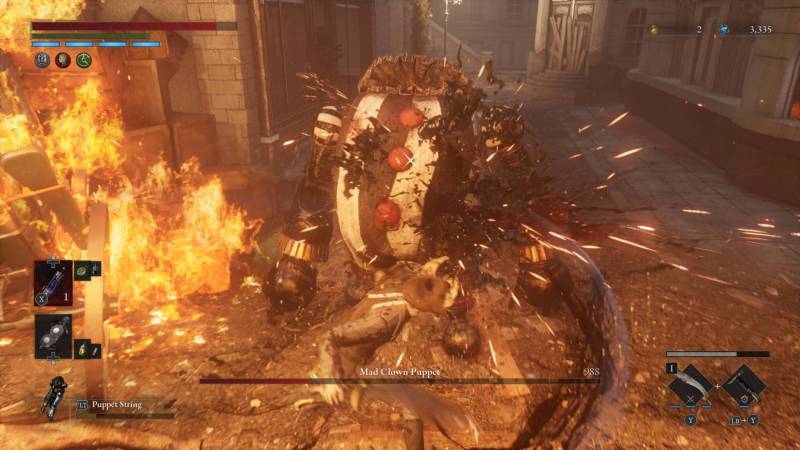
Get bonked again.
Anyway, to summarise the combat experience, I liked that you could tinker with your style on the fly and discover what worked best for you. What’s more, you didn’t seem to be overly tortured by taking a chance here and there.
These are pretty great improvements overall, and I feel that stimulating player creativity is something this genre has been missing.
Exploration-wise, there were also some noticeable improvements.
The maps seemed to be much tighter and more intuitive. This is definitely NOT an open-world game, but some maps have cleverly overlapping segments that allow you to unlock shortcuts back to safety the further you progress.
Many little items can be picked up, and thankfully, with the exception of the lore items, they are all pretty useful. This is largely because the consumables you find in the overworld are actually quite viable to use in combat as opposed to being inventory filler.
For example, throwing cells function as elemental bombs that are pretty abundant but also, provided they land, can do a decent chunk of damage to the target.
Having these in the back pocket makes it worth engaging with the maps, but the other reason is finding upgrade materials. These materials are the engine through which your capabilities and, therefore, combat abilities progress.
Quartz upgrades your heart (hilariously called a P-organ in the game) and allows you to enhance your character’s abilities/survivability; Legion calibers upgrade your cyborg’s arm, and moonstones upgrade your weapon damage/stats.
You will only get so far upgrading one thing, so having the resources to invest in your favorite gear is just as important as making sure that Pinocchio can heal themself on the fly.
The exploration synchronized nicely with the experimentation with combat because I felt the streamlining and looping maps that built back onto itself allow a player to focus on the meat of this game, which is, of course, fighting and fighting the best that you can.
It’s a really great experience.
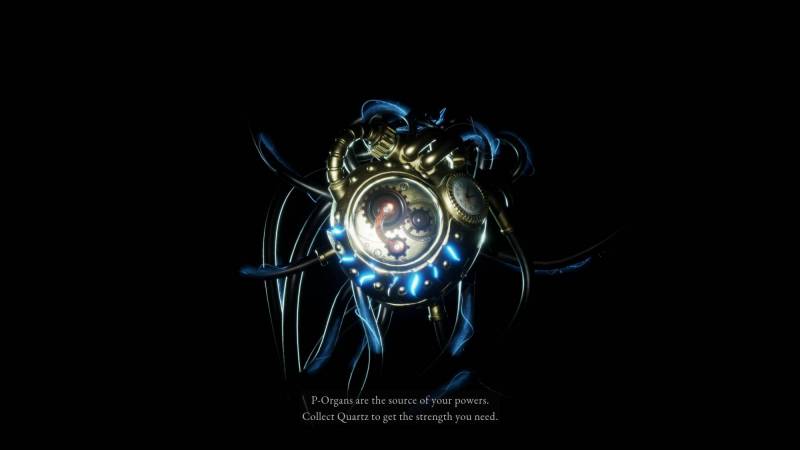
My P-organ is also the source of my power, so I get it.
Lies of P Criticism
“This game sounds too good to be true,” I hear you say. “Will this acquire Flint’s elusive 5/5 ranking for the first time ever?” Sadly no.
Lies of P was my Game of the Year from 2023, but there are still some things that I did not really find were necessary and hampered the experience a little. These are VERY small but need to be said nonetheless.
Firstly, there is a whole mechanic and skill tree associated with a resource called “Golden Coin Fruit.” The fruit has story relevance, but mechanically, it is designed to allow you to refund your experience and P-organ levels so you can try a different build or buff yourself or multiplayer friends that you summon to help take on bosses.
Undoubtedly, It can be useful, but it seemed to be an unnecessary tool that added another layer of resource management to a game already loaded with them.
This is the only resource that has dedicated branches of the skill tree focused on accruing more of it (by shortening the time between being able to harvest it). Honestly, I think most players will redo their character maybe once or twice at most; it just didn’t add much to the experience.
I would have just given refund opportunities via items dropped from beating certain milestone bosses and done away with the whole tree.
Another thing I had an issue with was a lackluster ending level compared to the rest of the game. Without spoiling anything, you find the big bad hiding on a secret island just off the coast of the city of Krat.
He has built up a fortress filled with mutants, robots, and supersoldiers while he sits at the very apex of the structure, attempting to reconstruct himself as a god. How droll.

The lead-up to the castle is fine, as it truly is a massive structure, and storming it solo from the beach can be quite a cinematic experience, but all this ends the moment you breach the first gate.
As you ascend, it’s just a dreary, dark, dank labyrinth that is chock-full of enemies and traps. It wasn’t particularly more challenging than other areas, just more obnoxious.
I think for an “ascent to the final boss” moment, it was lacking moxie and pizzazz overall.
Variety with quest design was also a bit lackluster in Lies of P, with a lot of the side quest lines chalking up to “go here, find an object, bring it back,” but I suppose this game wasn’t particularly designed around more complicated quest resolutions.
I did enjoy a series of side missions where you’re asked to decipher cryptic messages to find buried treasures and a little riddle game you play with an unseen psychopath; if possible, I’d like future games to incorporate this more.
It’s such a kooky setting that I think spicing up the structure of their side quests would go a long way when it comes to the overall experience for newer players.
My final comment is that I felt that the legion arms didn’t do that much for me. This could be totally incongruent with anyone else’s experience because, as mentioned, my combat style is extremely bonk-heavy, and I mainly used the arm to close distances. However, I still felt, in general, that the special abilities afforded to you were not that effective.
I did take a little time to test out the various members of the arsenal, and in my opinion, there isn’t enough utility to make them effective. Let’s take the shield arm, for example. While it may be helpful to have a backup shield, if you’re mastering the combat system, you will not need an extra layer of defense because you’ll be blocking most attacks anyway.
Another example is the electric shock arm. Puppets are extremely susceptible to lightning damage (duh), but the arm shoots so slowly and at quite a short range, so it would really only be useful against slower basic enemies. Based on my skill preference and combat style, I could not IMAGINE trying to use these against bosses who are incredibly quick and hit very hard.
Look, I’m not saying that they are unviable and that skilled players can’t use them with great success against the enemies that actually matter, but after trying all of them, only the harpoon was worthwhile to include.
Still, this could be ENTIRELY personal preference, so take this last assessment with a grain of salt.

I mean, just look at this thing!
Should You Play Lies of P?
Lies of P is a fantastic game that ascends from the “Dark Souls clone” moniker that it has been saddled with. This reminds me of Marvel’s Midnight Suns (a game I also reviewed), where I felt members of the public and perhaps members of the media community were either dismissive or at least slow to engage with aspects that made these titles truly avant-garde and unique.
It’s easy to denigrate something as derivative and, therefore, not worth your time, but I think those who yield to this bias are missing out on something quite fun. If you take anything away from this word salad I’ve typed, all I ask is that you give Lies of P a chance.
Lies of P has amazingly fluid gameplay once you get used to it, a beautiful atmosphere, a multitude of ways to overcome obstacles, and a pretty interesting story to boot. That makes this one of my favorite games in this genre, and while I will probably be taking a break to play some other titles, I will be 100 %-ing this, too.
Lies of P is an easy 4.5/5, and they are hinting at sequels and DLCs; I, for one, am pretty hyped about that.
Lies of P sells for $59.99; it is available directly from NEOWIZ and other retailers, including Steam, Amazon, Instant Gaming, and GameStop.
Developer: NEOWIZ
Publisher: NEOWIZ
Source: Personal Purchase
What I Like: Combat system that encourages experimentation: Creepy but beautifully designed world; Fluid gameplay; Interesting story; My “Game of the Year” from 2023
What Needs Improvement: Some not entirely useless but underdeveloped mechanics; A ho-hum endgame to cap off your journey

It would be interesting to see a mod to make characters look like the Disney versions.
The game sounds quite good. Thanks for the thorough review!